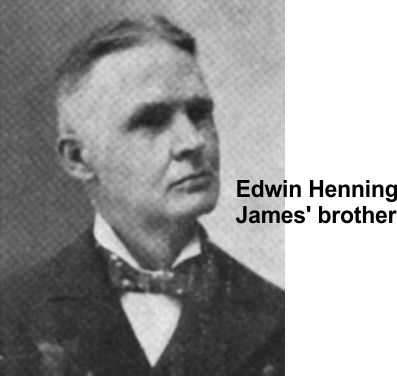|
Philadelphia-born Emily Josephine Pettit Henning (b. 1862), the wife of James
Henning, died on February 8, 1904, forty days after
the Iroquois Theater fire. She suffered both
burn and inhalation injuries.
Her four sons who died at the Iroquois:
- Five-year-old Charles "Charlie" C. Henning (b. 1898)
- Eight-year-old James Henning Jr. (b.1895)
- Twelve-year-old Edwin L. Henning (b.1891)
- Thirteen-year-old William C. Henning (b.1890) who would have turned fourteen in three days
Emily Henning was not told
of her son's deaths initially. One newspaper
reported that her death was hastened by the
knowledge of the loss of her sons, however, so she
was told of their deaths before she died. She
was laid to rest with her four boys lost at the
Iroquois, in the family plot with an older son,
Albert, lost in 1899 at age eleven. Husband
and father James joined them in 1928. (See section at right "Life for James Henning..." as to how James coped with the loss of his entire family.
Mrs. Pettit
Days after the fire, newspapers reported that Emily's injuries were not
serious, and that she would survive. In Leavenworth,
KS, on January 8, 1904, however, her mother was
interviewed by a newspaper and had a much different
report on her daughter's condition.
Some statements in the interview are so inaccurate
that I suspect they were fabricated by the newspaper
reporter so am only relating what has a possibility
of being true.
Mrs. Pettit traveled from Kansas to Chicago to visit Emily in the
hospital and described what she heard or read
during her visit. Emily was bandaged and had
most probably been given morphine but recognized her
mother's voice and was able to speak.
According to Mrs. Pettit's newspaper interview, Emily was found inside the
auditorium by firemen, clutching the hand of her
youngest son, Charlie. The fireman thought both were
dead and carried them to Thompson's Diner next to
the theater, where Emily regained consciousness. She
spoke to a priest, asking him to call her husband at
Anson Hall.
Emily was badly burned with her hair gone and burns covering her upper
body. Physicians thought a deep burn on one arm
might prove fatal.
Of James' search for the bodies of his sons, Mrs. Pettit reported that he and his brother,
Edwin Henning (1852-1918),* found Charlie's body at Thompson's
Diner. William's body
was found at a morgue and identified by the chain
and clasp from his mother's chatelaine bag, as well
as $25. Edward was also
found at a morgue but his face was
gone. A Sunday School paper in his pocket
identified his body.
The search for Jimmy's body as reported elsewhere, based on interviews with James
While James Sr. tended to Emily in the hospital, and made arrangements for the
burial of his other three sons, he desperately tried to find Jimmy's body.
He got a list from the coroner's office of other Iroquois victims Jimmy's
age. He sent letters to their families, asking if there was any chance they
had made a mistake in identifying their boy's bodies.
The mix-up
One of the letter recipients was the attorney for the Palmer family.
The entire Palmer family of four had died at the Iroquois — mother,
father and two sons. A group of friends and relatives looked
for their bodies and identified a boy they thought was
Howard Palmer.
|

|
Some newspapers reported
the body had already been buried and had to be
disinterred for examination. Other newspapers said
the Palmer family bodies were awaiting shipment to
Philadelphia for burial. Given January temperatures,
interment was unlikely. Jimmy's body was stored
in a crypt until the ground thawed.
The boy thought to be the Howard Palmer was examined by dentist,
Dr. Victor H. Fuqua, and declared to be Jimmy Henning. The
Palmers attorney hired a detective, involved their
family dentist who agreed it was not Howard. The correct Howard Palmer was
found at a morgue on January 16, 1904. A piece
of that story, probably related to body condition,
was not reported and is not known. All but
four bodies had been identified over a week earlier,
according to newspapers. No mention then of an
unidentified boy's body.
By January 28, 1904, four weeks after the fire, James Henning had
the bodies of all four of his sons and could
concentrate on Emily.
In Kansas, Mrs. Pettit gave another interview, this one about the discovery of her grandson's body. Mrs. Pettit, however, said it was five-year-old Charlie who was missing. Chicago papers, who had the opportunity to speak directly with James, reported multiple times that it was Jimmy's body that was missing so either the reporter couldn't read his notes or grandma Pettit misspoke.
Mrs. Pettit said her son-in-law had helped
authorities identify several bodies. Perhaps James
had a hand in straightening out the mix-up with the
Corbin and Greenwald boys.
According to Mrs. Pettit,
James Henning's late father, David Henning, had bequeathed an allowance and college fund
for each of the four boys. David Henning was a
prosperous barrel maker, apple grower (nicknamed
"Apple King") and owned four municipal gas utility
plants in Michigan, Missouri and Kansas.

It was said that he'd introduced the idea of shipping fruits in barrels
rather than in boxes. One year his cooperage made
too many barrels, so he offered apple-filled barrels
as a promotion to sell the excess barrels. It was so
successful that he was soon in the apple growing
business. One of James' nephews, David Henning
Frazer, took over his grandfather's business
interests.
Life for James Henning after the Iroquois Theater fire
After the fire, James Henning abandoned his business interests and
retired. After a period of withdrawal, he finally
sent a letter to his brother, Edwin, saying he
was traveling and okay, trying to cope with his
grief. For the next three years, Edward received
occasional letters from James, sent from around the
world.

Temporarily institutionalized
In March 1907, James was aboard the steamship Cedric on route from London to New York when he became loud and emotional
about the deaths of his family, and resisted leaving a public area. The ship officials
put him in a straitjacket for the remainder of the voyage. On landing in New York, James was taken to
Bellevue hospital, and his brother, Edward, was summoned from Chicago. James was transferred
to a private sanitarium, Sanford Hall, in Flushing, NY.
|
